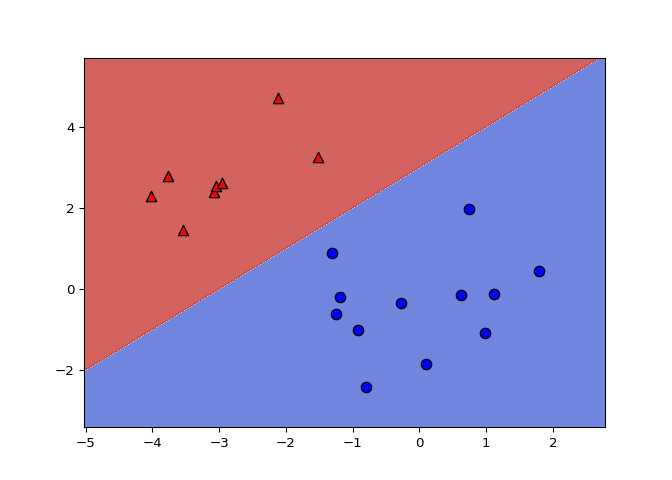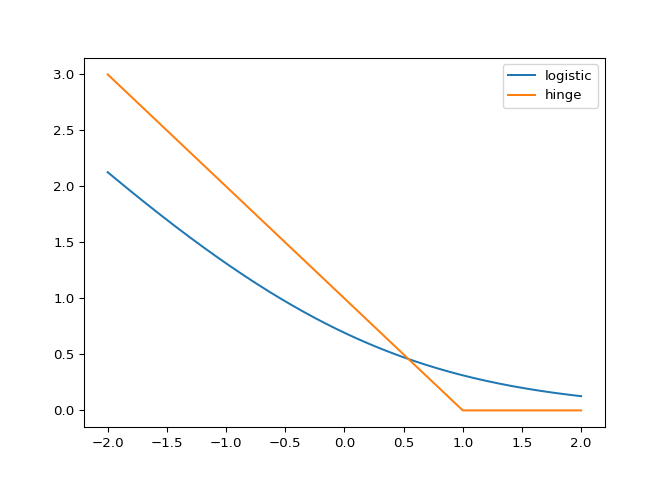Loss functions
Contents
Loss functions#
In this chapter you will discover the conceptual framework behind logistic regression and SVMs. This will let you delve deeper into the inner workings of these models.
Linear classifiers: the coefficients#
How models make predictions#
Which classifiers make predictions based on the sign (positive or negative) of the raw model output?
Logistic regression only
Linear SVMs only
Neither
Both logistic regression and Linear SVMs
Changing the model coefficients#
When you call fit with scikit-learn, the logistic
regression coefficients are automatically learned from your dataset. In
this exercise you will explore how the decision boundary is represented
by the coefficients. To do so, you will change the coefficients manually
(instead of with fit), and visualize the resulting
classifiers.
A 2D dataset is already loaded into the environment as X
and y, along with a linear classifier object
model.
# edited/added
X = np.array([[ 1.78862847, 0.43650985],
[ 0.09649747, -1.8634927 ],
[-0.2773882 , -0.35475898],
[-3.08274148, 2.37299932],
[-3.04381817, 2.52278197],
[-1.31386475, 0.88462238],
[-2.11868196, 4.70957306],
[-2.94996636, 2.59532259],
[-3.54535995, 1.45352268],
[ 0.98236743, -1.10106763],
[-1.18504653, -0.2056499 ],
[-1.51385164, 3.23671627],
[-4.02378514, 2.2870068 ],
[ 0.62524497, -0.16051336],
[-3.76883635, 2.76996928],
[ 0.74505627, 1.97611078],
[-1.24412333, -0.62641691],
[-0.80376609, -2.41908317],
[-0.92379202, -1.02387576],
[ 1.12397796, -0.13191423]])
y = np.array([-1, -1, -1, 1, 1, -1, 1, 1, 1, -1, -1, 1, 1, -1, 1, -1, -1,
-1, -1, -1])
model = LogisticRegression()
model.fit(X, y)
# Set the coefficients
## LogisticRegression()
model.coef_ = np.array([[-1,1]])
model.intercept_ = np.array([-3])
# Plot the data and decision boundary
plot_classifier(X,y,model)
# Print the number of errors

num_err = np.sum(y != model.predict(X))
print("Number of errors:", num_err)
## Number of errors: 0
Great job! As you’ve been experiencing, the coefficients determine the slope of the boundary and the intercept shifts it.
What is a loss function?#
The 0-1 loss#
Least squares: the squared loss
scikit-learn’s
LinearRegressionminimizes a loss: $\(\sum\_{i=1}^{n}(\text{true ith target value - predicted ith target value})^2\)$Minimization is with respect to coefficients or parameters of the model.
Classification errors: the 0-1 loss
Squared loss not appropriate for classification problems
A natrual loss for classification problem is the number of errors
This is the 0-1 loss: it’s 0 for a correct prediction and 1 for an incorrect prediction
But this loss is hard to minimize
In the figure below, what is the 0-1 loss (number of classification errors) of the classifier?

0
1
2
3
Minimizing a loss function#
In this exercise you’ll implement linear regression “from scratch” using
scipy.optimize.minimize.
We’ll train a model on the Boston housing price data set, which is
already loaded into the variables X and y. For
simplicity, we won’t include an intercept in our regression model.
LinearRegression.
# edited/added
import pandas as pd
from scipy.optimize import minimize
from sklearn.linear_model import LinearRegression
X = pd.read_csv('archive/Linear-Classifiers-in-Python/datasets/boston_X.csv').to_numpy()
y = pd.read_csv('archive/Linear-Classifiers-in-Python/datasets/boston_y.csv').to_numpy()
# The squared error, summed over training examples
def my_loss(w):
s = 0
for i in range(y.size):
# Get the true and predicted target values for example 'i'
y_i_true = y[i]
y_i_pred = w@X[i]
s = s + (y_i_true - y_i_pred)**2
return s
# Returns the w that makes my_loss(w) smallest
w_fit = minimize(my_loss, X[0]).x
print(w_fit)
# Compare with scikit-learn's LinearRegression coefficients
## [-9.16299769e-02 4.86754601e-02 -3.77616187e-03 2.85635921e+00
## -2.88073141e+00 5.92521965e+00 -7.22450907e-03 -9.67993759e-01
## 1.70448640e-01 -9.38968004e-03 -3.92422032e-01 1.49830751e-02
## -4.16972374e-01]
lr = LinearRegression(fit_intercept=False).fit(X,y)
print(lr.coef_)
## [[-9.16297843e-02 4.86751203e-02 -3.77930006e-03 2.85636751e+00
## -2.88077933e+00 5.92521432e+00 -7.22447929e-03 -9.67995240e-01
## 1.70443393e-01 -9.38925373e-03 -3.92425680e-01 1.49832102e-02
## -4.16972624e-01]]
Great job! This was a tough one. Isn’t it cool how you reproduce the
weights learned by scikit-learn?
Loss function diagrams#
Classification loss functions#
Which of the four loss functions makes sense for classification?

(1)
(2)
(3)
(4)
Comparing the logistic and hinge losses#
In this exercise you’ll create a plot of the logistic and hinge losses using their mathematical expressions, which are provided to you.
The loss function diagram from the video is shown on the right.
log_loss() and hinge_loss()
functions at the grid points so that they are plotted.
# Mathematical functions for logistic and hinge losses
def log_loss(raw_model_output):
return np.log(1+np.exp(-raw_model_output))
def hinge_loss(raw_model_output):
return np.maximum(0,1-raw_model_output)
# Create a grid of values and plot
grid = np.linspace(-2,2,1000)
plt.plot(grid, log_loss(grid), label='logistic')
plt.plot(grid, hinge_loss(grid), label='hinge')
plt.legend()
plt.show()

Nice! As you can see, these match up with the loss function diagrams we saw in the video.
Implementing logistic regression#
This is very similar to the earlier exercise where you implemented
linear regression “from scratch” using
scipy.optimize.minimize. However, this time we’ll minimize
the logistic loss and compare with scikit-learn’s
LogisticRegression (we’ve set C to a large
value to disable regularization; more on this in Chapter 3!).
The log_loss() function from the previous exercise is
already defined in your environment, and the sklearn breast
cancer prediction dataset (first 10 features, standardized) is loaded
into the variables X and y.
range().
LogisticRegression.
# edited/added
X = pd.read_csv('archive/Linear-Classifiers-in-Python/datasets/breast_X.csv').to_numpy()
y = pd.read_csv('archive/Linear-Classifiers-in-Python/datasets/breast_y.csv').to_numpy()
# The logistic loss, summed over training examples
def my_loss(w):
s = 0
for i in range(y.size):
raw_model_output = w@X[i]
s = s + log_loss(raw_model_output * y[i])
return s
# Returns the w that makes my_loss(w) smallest
w_fit = minimize(my_loss, X[0]).x
print(w_fit)
# Compare with scikit-learn's LogisticRegression
## [ 1.03608522 -1.65378403 4.08314729 -9.40923525 -1.06786728 0.0789288
## -0.85110209 -2.44102633 -0.4528562 0.43353478]
lr = LogisticRegression(fit_intercept=False, C=1000000).fit(X,y)
## /Users/macos/Library/r-miniconda/envs/r-reticulate/lib/python3.8/site-packages/sklearn/utils/validation.py:985: DataConversionWarning: A column-vector y was passed when a 1d array was expected. Please change the shape of y to (n_samples, ), for example using ravel().
## y = column_or_1d(y, warn=True)
print(lr.coef_)
## [[ 1.03665946 -1.65380077 4.08233062 -9.40904867 -1.06787935 0.07901598
## -0.85099843 -2.44107473 -0.45288928 0.43348202]]
Great job! As you can see, logistic regression is just minimizing the loss function we’ve been looking at. Much more on logistic regression in the next chapter!
